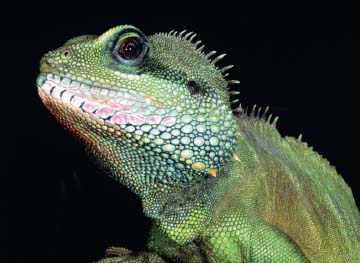
GENERAL INFORMATION
Despite their protected status in several countries, green water dragons are still imported in large numbers for the pet trade. This is not altogether surprising, considering these semi-arboreal Asian reptiles are among the best large lizard pets available. They are attractive, can be handled, and display well. Most adapt well to captivity and readily breed in proper captive conditions. They do not grow nearly as large as green iguanas and tend to be somewhat calmer. Iguanas often display more responsive behaviors and more signs of intelligence than water dragons, but a somewhat less responsive personality has certain advantages. Green water dragons are less likely to become stressed when moved to a new enclosure. Unlike iguanas, they can also be displayed in large, attractive, planted vivaria and are less likely to damage landscaped plants and materials than most other large lizards.

Male green water dragons can eventually grow large enough to require enclosures at least 5 feet long. If raised from babies, many become quite tame and will not smash their snouts on the cage walls, a behavior common in larger imports.
Australian water dragons (Physignathus lesueurii), like this male, are bred in very small numbers in the United States. Proper winter cooling, with temperatures dropping into the low 60s F at night, is necessary for successful breeding.
In scientific nomenclature, green water dragons are classified as Physignathus cocincinus, one of the largest members of the Old World family Agamidae. Two other Physignathus species are occasionally offered in the herpetocultural trade: the Australian water dragon, Physignathus lesueurii, and the small Southeast Asian Physignathus temporalis.
Distribution: Green water dragons are found on the mainland of Southeast Asia and the Indo-Australian archipelago. Most imported specimens are from Thailand or southern China.
Size: Large male water dragons can reach more than 3 feet in total length. Females are typically smaller.
Sexing: With age, males develop comparatively larger heads, larger jowls, and a larger crest behind the neck. The femoral pores of adult males are slightly larger than those of females.
Longevity: Green water dragons have a life span comparable to that of an average dog. If initially healthy and well maintained, a captive green water dragon can be expected to live more than ten years. The longevity record for the species is just over fifteen years.
This male green water dragon rests on a branch.
Management of Wild Populations
If managed properly, green water dragons could become a significant economic resource in countries where they occur. However, without proper management, habitat destruction and excessive exploitation could easily cause this species to become threatened. Over the years, they have been exploited for food and, more recently, to supply the reptile pet trade. As a result, both adults and juveniles are under hunting and collecting pressure. Sound management policies should protect natural habitats, implement collecting seasons, and possibly establish quotas.
Male water dragons (right) exhibit enlarged jowls and nuchal crests compared with the smaller features of females (left).

As evidenced by this beautiful specimen, green water dragons have stunning coloration.
Managed field harvesting may be the most economical method for a sustained yield. The relatively low reproductive rate of green water dragons and relatively low current market prices do not make the current development of the commercial herpetoculture of these lizards economical. However, should sound management policies fail to be implemented, commercial herpetoculture of green water dragons is feasible and should be encouraged. To ensure the future availability of these lizards, all private herpetoculturists interested in green water dragons are encouraged to maintain breeding pairs or groups. Why not breed these animals while they are still available? Except for the extra space requirements, two or three water dragons are really not much more work than keeping one.
Adult green water dragons, like this female, are omnivorous, feeding on a wide variety of both live or dead prey as well as various fruits and vegetables. An animal captive-raised under optimal conditions will grow to be an impressive sight.